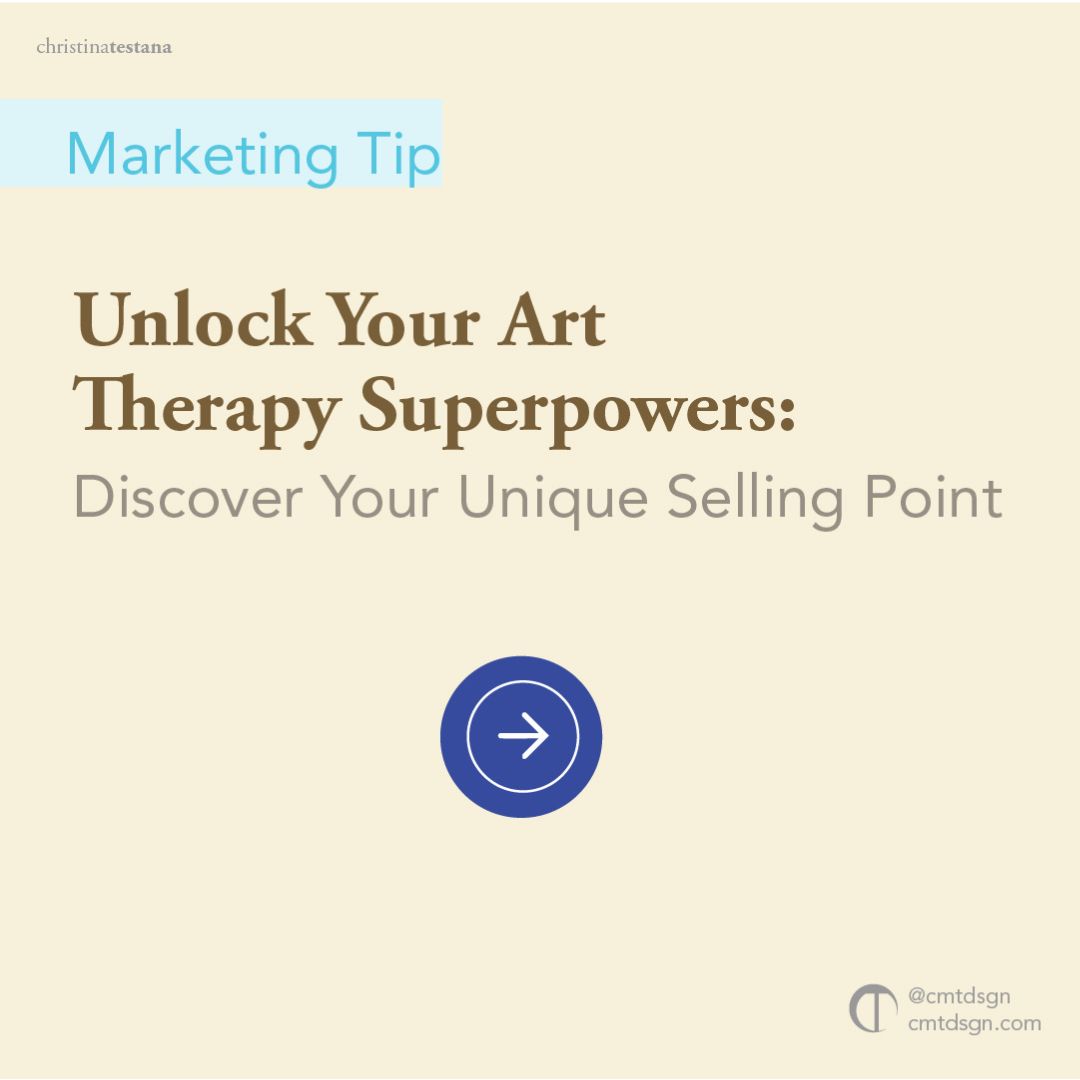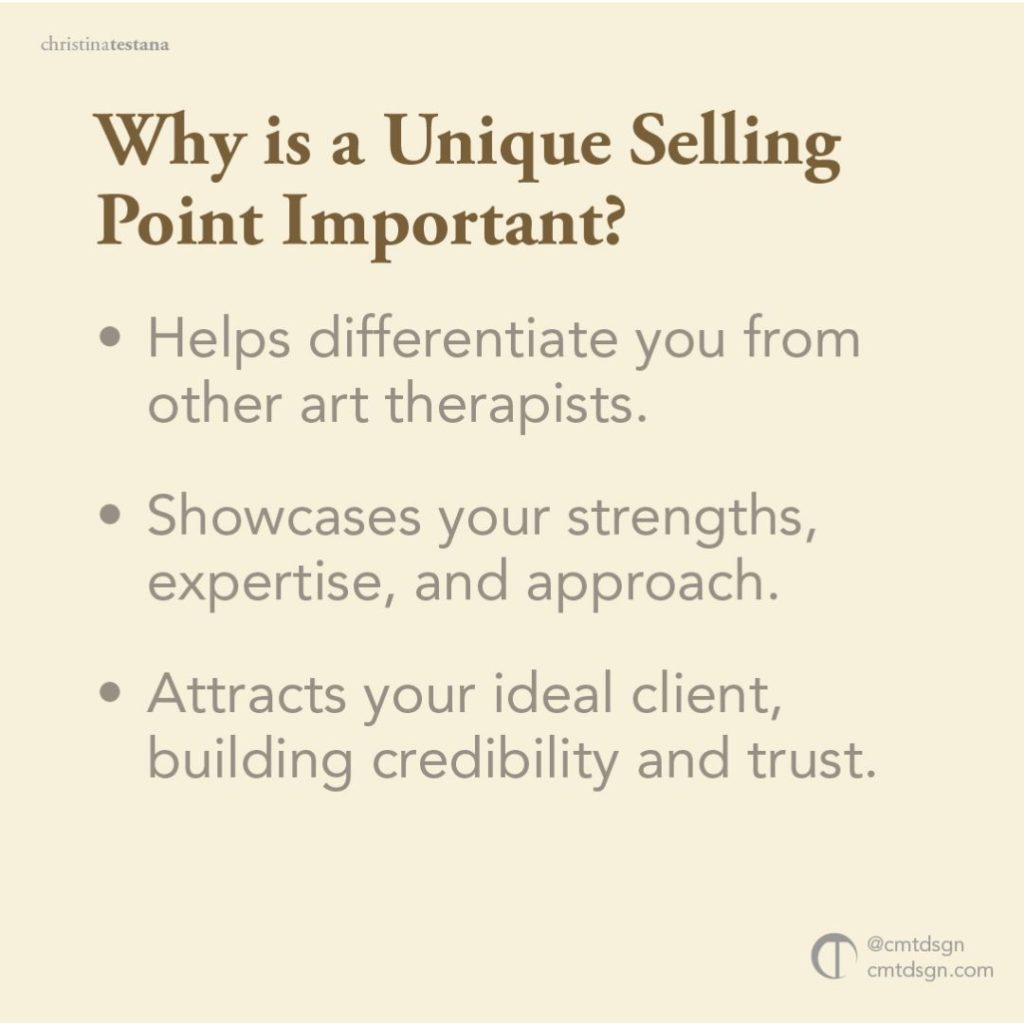
Are current swimming in a deep sea of sameness?
Are you a proactive art therapist looking to make a positive impact on your art therapy business?
Do you desire to find your true direction and create a loyal community of clients who truly value your unique talents?
If you are nodding your head consistently “Yes!” to these questions, then this reading is for you.
In today’s noisy unsteady world and the growth and need of mental health services and art therapy. It’s essential to distinguish yourself and stand out from the crowd.
Your business journey starts with finding your unique selling point, a powerful method that sets you apart as an art therapist and positions you as a guiding light of hope and transformation in the lives of your ideal client.
But why is finding your unique selling point so essential?
How can it help you bring positive change to your art therapy business and build deep connections with a community of loyal clients who truly appreciate your work?
That’s what we’re about to uncover together.
In today’s reading, I’ll dive into the realm of discovering your direction as an art therapist, understanding your ideal client’s needs, and building a strong and lasting connection with a community that values your expertise.
I’ll explore practical strategies to help you identify your strengths, assess market gaps, and communicate your unique story effectively.
Whether you’re just starting your journey as an art therapist or seeking to revamp your existing practice, this guide will equip you with the knowledge and insights needed to unleash your potential and shine in the art therapy market.
It’s time to embrace your individuality and carve out your place in the hearts and minds of those who seek your guidance.
So, are you ready to set sail on this transformative journey to find your unique selling point?
Let’s take the first step together and unlock the secrets to standing out in the art therapy market.
Your authentic voice and the loyal community you’ve always dreamed of are waiting to be discovered.
I’ll explore how to understand your ideal client, pinpoint your strengths and expertise, identify market gaps, define your unique selling point, and build an community that celebrates your art therapy journey.
Remember, your journey begins here, and the possibilities for growth and impact are limitless.
Let’s dive in and embrace the extraordinary path that lies ahead.
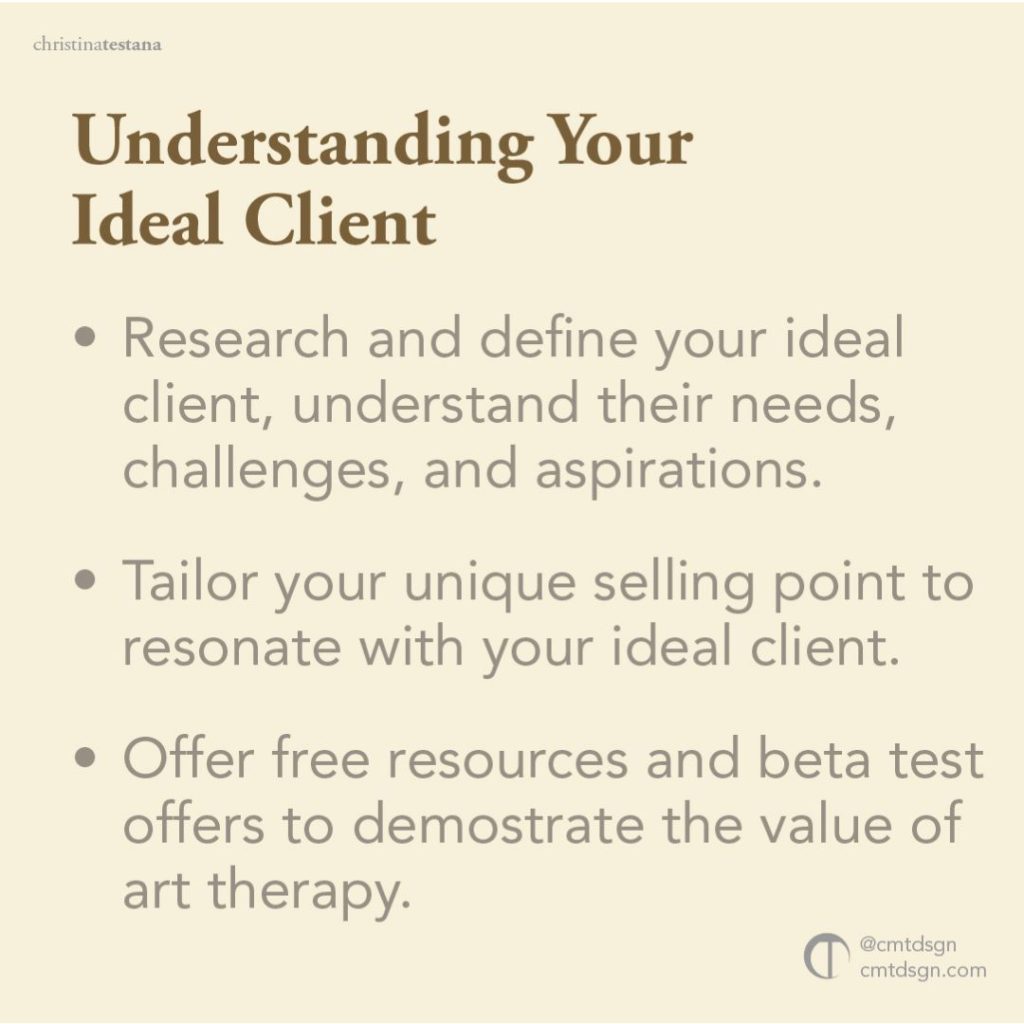
Understanding Your Ideal Client
First things to address in finding your unique selling point is to identify your ideal art therapy client. Remember the business and brand is not about you its about your ideal client. It’s essential to ensure your brand speaks to them through that unique selling point you build.
This approach will grow and build a loyal community that suits you and what you do best.
The unique selling point will mention the ideal client you wish to help so make time to research on this specific person. Learn about them from the inside out.
A great place to start your research is to find out their needs, challenges, and desires. These are they key component to establishing trust and connection between you and your art therapy clients. This builds that loyal community you desire.
These key components help to know how they are on the inside and to find out how to speak directly to them.
Another area to understand and dig into is the Art Therapy Market, check to see what’s in demand and what’s trending.
It’s good to know whats going on in your market and what clients are actually looking for in art therapy business but aren’t addressing it.
These are called market gaps and this is the secret to finding opportunities.
Having an idea of what your ideal clients want out of an art therapist that no one else is going gives you the advantage to reach that need.
Action step:
Look to your current client base or network of family and friends. Who stands out to you and is your favourite to be around and enjoy helping? Pick one person that you would love to help and find more people like them.
See if you can have a mini interview with them to ask them about what are their needs and wants, challenges, and desires. This gives you the ingredients you need to build out an amazing unique selling point statement.
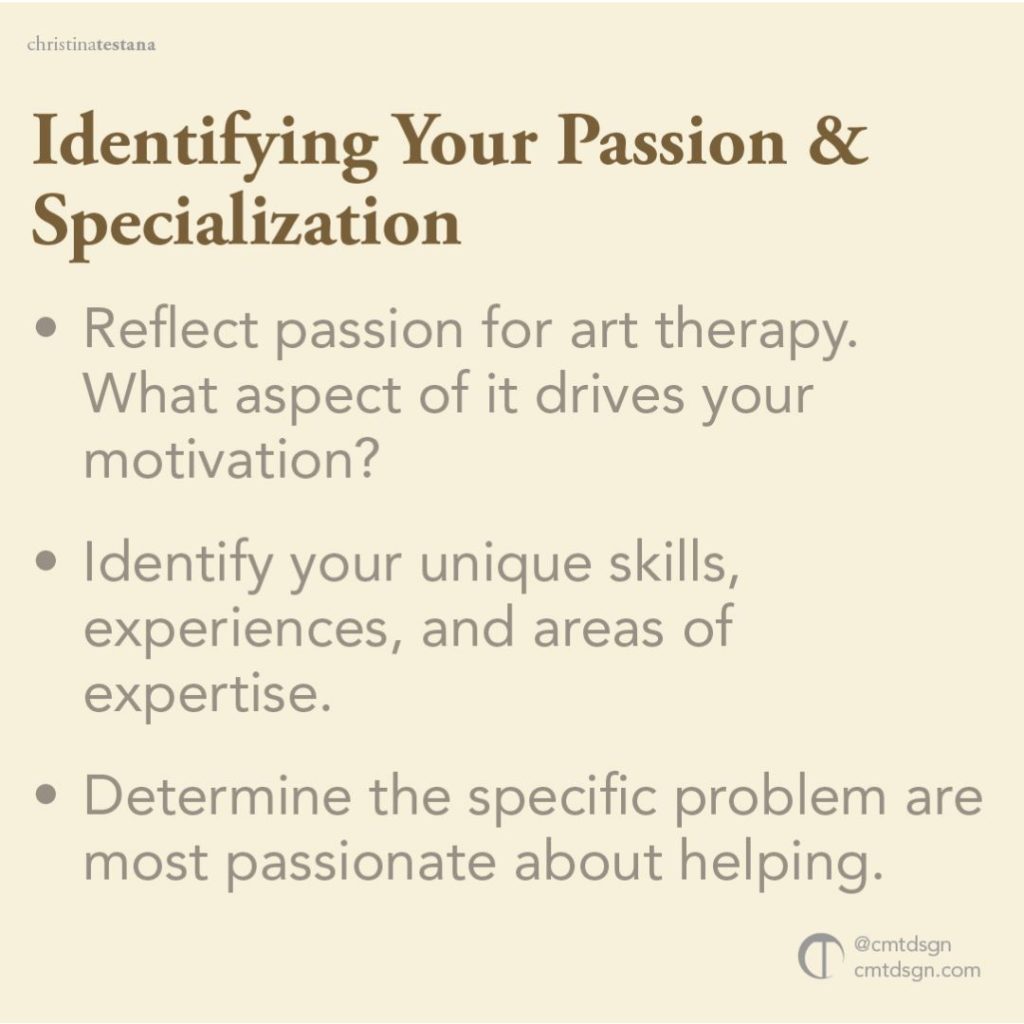
Pinpoint Your Strengths and Expertise
Strengths to form a unique selling point
As a person we all hold certain strengths and its up to you to figure out what they are. Knowing your core strengths as an art therapist brings positive change to your art therapy business because it will be one of your pillars in finding ways to stand out because not every art therapist is like you.
Instead of trying to make your weaknesses your strengths, let’s focus on enhancing what you already got and what people constantly say about you. If you are wondering what those strengths could be, look to your personality traits, innate unique skills, and talents.
If you need a little bit of guidance in finding your strengths. You can ask your family and friends or colleagues in your inner circle or try out these resources to explore!
It gives you a framework of your personality type. They mention what your strengths are and you can pull right from there! Just pick one strength you can enhance and work with the best.
Myers Briggs Test https://www.16personalities.com/free-personality-test
THE ENNEAGRAM PERSONALITY TEST https://www.truity.com/test/enneagram-personality-test?ppcga=fixed&gad=1&gclid=CjwKCAjws7WkBhBFEiwAIi1686-_f1veyuhWaSApq0EMuMxp52j5UHWiiJyhub7JjMgetGiUzUxAXBoCE80QAvD_BwE
Highlight your core expertise and unique approach
The next component is finding direction in the area of your expertise leading to specializing. Take the time to reflect on your art therapy journey, pinpoint problems you solved that you consistently deliver exceptional results. Pick one specific problem you enjoy working with and that is effortless to solve. You must feel a sense of curiosity and passion to go even deeper into that specific problem.
Alongside knowing the specific problem you solve, now its about the approach. The area of specialization and niching down to a certain method.
I know art therapists fear leaving too much on the table but you will thrive in the market much easier if you start small and with what you are the best at. You can expand later.
Right now it’s about being known for something that will make you memorable and be that go to therapist, Everyone’s style of therapy is different and unique in nature. Think about the techniques, methods, or modalities in which you feel particularly skilled and confident. Emphasize your specialized knowledge, certifications, or training that sets you apart from other proactive art therapists.
Showcase any unique approaches, methodologies, or frameworks you use in your practice that bring value and produce positive outcomes for your ideal client.
Another point to look at is your passions in the area of mental health, what gets you going? What triggers you, annoys you in the area of mental health or constantly find yourself talking about endlessly? These are things your are passionate about.
Example can be, setting boundaries with other family members given the global issue of sustainable housing. Where you have multi-generations living in one home. This passion can be a specific problem you solve and specialize in.
Action step:
Pick one specific problem and approach that you enjoy the most and are the best at delivering and going further in enhancing them.
If you are unsure about what problem you are good at solving and the best approach. You can always look to your clients and colleagues to gain insights from another’s perspective.
Identifying these areas will make focusing so much easier and you will utilize your energy on improving your strengths to ensure your unique selling point is strong.
By effectively communicating your expertise and unique approach, you position yourself as a standing out proactive art therapist.
With a distinct unique selling point, attracting clients who resonate with your methods and appreciate the positive impact you can make in their lives.
Conducting a Self-Assessment
If you are a little anti-social and don’t want to ask people about you. You can always do a reflection self-assessment session with yourself.
Take our your journal and start looking to your past and gather highlights from your professional journey and accomplishments as an art therapist. These can help direct you on where you should focus your energy.
You could look back at feedback you received from past clients and colleagues to find your answers. You never know what might pop up that you completely missed.

Identifying Market Gaps and Opportunities
This is a continuation from knowing your ideal client in point one. Make time to analyze the current art therapy market because it’s constantly changing every quarter to a year. As an entrepreneur art therapist it’s your responsibility to stay up to date in your art therapy business.
The world is changing quickly and the mental health market is forever expanding especially during this global mental health crisis. You have to be that detective and look for gaps or unmet needs in the mental health market.
It might require you to pivot your art therapy business because it might better suit you and it could be a good opportunity for positive change.
Be aware that finding direction might change over time but this is why you always check in with your business on a quarterly to yearly basis.
Don’t be afraid to explore potential opportunities for business differentiation your unique selling point might shine it’s best there.

Uncovering Your Unique Selling Point
Defining Your Unique Selling Point
It’s time to combine all your findings from, ideal client, strengths, expertise and market gaps to craft your unique selling point.
This is how you define your sweet spot in the market and differentiate yourself. With these three components in compilation with each other will highlight what sets you apart from other art therapists so be sure they are clear.
How to communicate those three special things about you?
The method is through a compelling and concise statement that clearly shares your unique selling point that makes up your Art Therapy business.
This statement is called a brand positioning statement, it tells people your stance in the market, who you are here to help, and what you bring to people. It must be short and too the point.
Action step:
Use this formula to get started on your unique selling point statement/ brand position statement. It’s like mad libs just plug in your information within the brackets
I help [ideal client + specific problem] by [strength + your solution/expertise/market gap] so [one ideal client desire].
Here’s an example:
I help young adults who are striving to be musicians find their creative expression through spiritual focused therapeutic art so that they have a safe space to reconnect with themselves.
Emphasizing Your Specializations
This unique selling point statement/ brand position statement emphasizes your specialization to other people. Filtering through the noise of the world to bring you the right clients. The statement demonstrates the value you bring to clients as an art therapist in just ONE sentence. People will feel much more comfortable when you are communicating clearly this way so there is no confusion or assuming.
Communicating Your Unique Selling Point To The World
Applying your Unique Selling Point: Now you have crafted your magical statement that will call to the chosen ones.
It’s time to put it to the test by incorporating it into your communication materials, which is your branding and marketing materials. Art Therapist Marketing can look different for every art therapist so you decide the medium, text, video, images, or audio.
The idea is to take this statement and streamline this consistent messaging across your main channels in your art therapy business.
It can be on Instagram, YouTube, TikTok, Facebook, blog, and email, .etc but focus on where your ideal client hangs out. Through your art therapist marketing you want to consistently communication your unique selling point so people understand your stance in the world.
Building Your Art Therapy Brand
Visually express your unique selling point
Speaking of branding, your brand identity and messaging need to work together to convey your unique selling point statement and paint the picture.
Your Art Therapy Brand unique selling point statement needs to streamline visually and contextually to form a collective approach to expanding your position in the market.
This approach to communicating your uniqueness will strengthen the value you bring and help you stand out and people grasp your what you do instantly. Through the different formats in visual form which is imagery, illustrations, logo, colours, fonts, other graphics and video.
These are all surface level communication that give them a glimpse of your unique selling point getting them engaged to go deeper.

Contextually show unique selling point
On a messaging stand point you have your positioning statement in place but now its time to craft supporting elements. This is a brand story. What you have crafted is what you are striving to do in the market right now in this time.
This is your short term goal. Now it’s about connecting that unique selling point statement with your why using the power of story. Develop one to three different stories about a past experience, something you witnessed or what is going on globally.
The story needs to relate to the problem you solve and the solution you bring on top of resonating with your ideal client. You have to uniquely write the story as if the ideal client see them in your story so they experience an emotional response.
Giving them insights into why you are here, and why you exist to help back up your unique selling point.
You see how your unique selling point statement brings positive change to your art therapy business because you have a focus and things are streamlined effortlessly creating a loyal community from all the clarity you created in your messaging.

Crafting Your Marketing Materials
How does your uniques selling point statement fall into your art therapy marketing? First off when you are rolling out your content marketing you are pulling from your unique selling point. You know that specific problem you pledge to focus on?
This is where your content jumps in and you produce niched content directly focusing on the specific problem, the ideal client and sharing your approach in solving that problem.
You now see how much of a role your unique selling point has in all of your marketing materials. Even your website and online profiles need to state this unique selling point at the beginning of your pages.
For example:
On your website splash page at the very top in the banner, you should mentioned your unique selling point statement. It doesn’t need to be word for word but you should use its essence. People who comes to your website want to know in a few seconds who you are and what you do.
IF nothing is stated they will move on. On social media profiles, your unique selling point should be clear in your bio section and even the limited space. Make it even more concise and clear and cut it down to the barebones. State the ideal clients and their desire. If they want to learn more they can contact you.
I would also utilize user generated content to your advantage. They will be your best source for helping to explain your unique selling point from a different perspective that other potential clients would understand.
Share your past clients success stories or case studies that demonstrate the effectiveness of your expertise and approach to help you in standing out.
As a proactive art therapists its essential to prioritize client’s testimonials in each of your sessions so that they can help you highlight the unique benefits and experiences they had working with you.
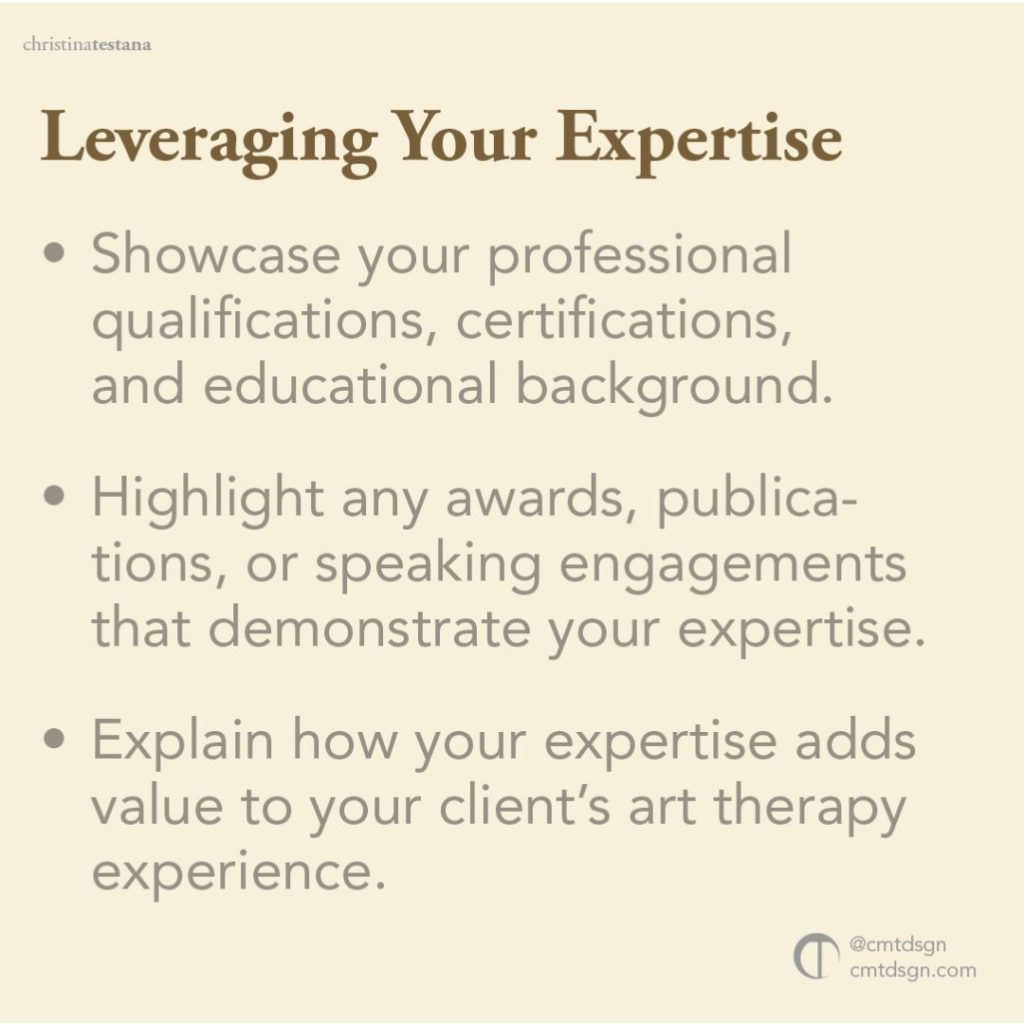
Building a Loyal Community
Connecting with Your Ideal Client Audience
Now that your unique selling point statement is a tool helping to filter through the people to find the desire people that you want. Now it’s up to you to continue nurturing those relationships.
That way when it comes to creating and offer and launching it you will have a audience that you can speak to.
You took time to nurture them and now they will give back to you through referrals and word-of-mouth marketing the best art therapists marketing for any healer.
This is why you need to understand the needs and aspirations of your ideal client so they keep coming back to you.
This is how meaningful relationships start and how effective communication works to reach those people you want and start connecting.
Providing Exceptional Value
Your unique selling point statement gives the ideal client an ideal of the value and experience you bring to them. With this shift in your art therapy business and the positive change in finding your direction and value proposition.
Now its about going above and beyond to exceed your ideal client’s expectations.
The unique selling point statement only shares so much and now when they engage you want to amp up what you bring. Offer unique and valuable services or resources to become that go to art therapist.

Monitoring and Adjusting Your Unique Selling Point
With anything you have to always check in and see how your art therapy business is doing with the new unique selling point.
You can say that your unique selling point statement is a hypothiesis and it needs to be tested for six months to a year to know if this is a need in the market.
How to track the effectiveness of your unique selling point? Start with sales rate, increase rate of how many people are finding out about you, and how long clients stay with you.
You can look at how ofter people visit your website or how happy your clients are. Collect data on the following: answers through surveys, and how much you sell each day.
It’s all about trial and error and gathering feedback from clients and make adjustments in finding direction.
Listen to what people say
Pay attention to what your clients say about your products or business. This includes things they write in reviews, testimonials, or social media posts. Look for common things people say to see if your unique selling point is making them like you more.
Ask customers directly
Get feedback from customers by asking them questions in surveys or interviews. Find out if your unique selling point statement influenced their decision to buy from you. This will help you understand how well your unique selling point statement is working.
Embracing Continuous Growth
Stay adaptable and open to evolving industry trends as a proactive art therapist. Keep checking and making changes: Regularly review the information and feedback you gather to see if your unique selling point statement is still effective.
If you find areas where you can improve, make changes to better meet what your ideal client wants. Keep working on your unique selling point statement to stay ahead of the competition and appeal to your ideal client.
In conclusion, as an art therapist, discovering and showcasing your unique selling point is vital for standing out in a competitive market.
By understanding your ideal client, uncovering your strengths and expertise, and identifying market gaps, you can define a compelling unique selling point that sets you apart from other art therapists.
Communicating this unique selling point effectively through your branding and marketing materials helps build your art therapy brand and connect with your ideal clients.
By consistently delivering exceptional value and cultivating a loyal community, you can establish a strong presence in the industry.
However, it’s important to monitor the effectiveness of your unique selling point and adapt as necessary to stay relevant and meet evolving client needs. Embrace continuous growth, stay informed about industry trends, and seek feedback to ensure your unique selling point remains impactful. Remember, by unleashing your art therapy potential and embracing your uniqueness, you can confidently stand out in the market and make a positive impact on those you serve.
